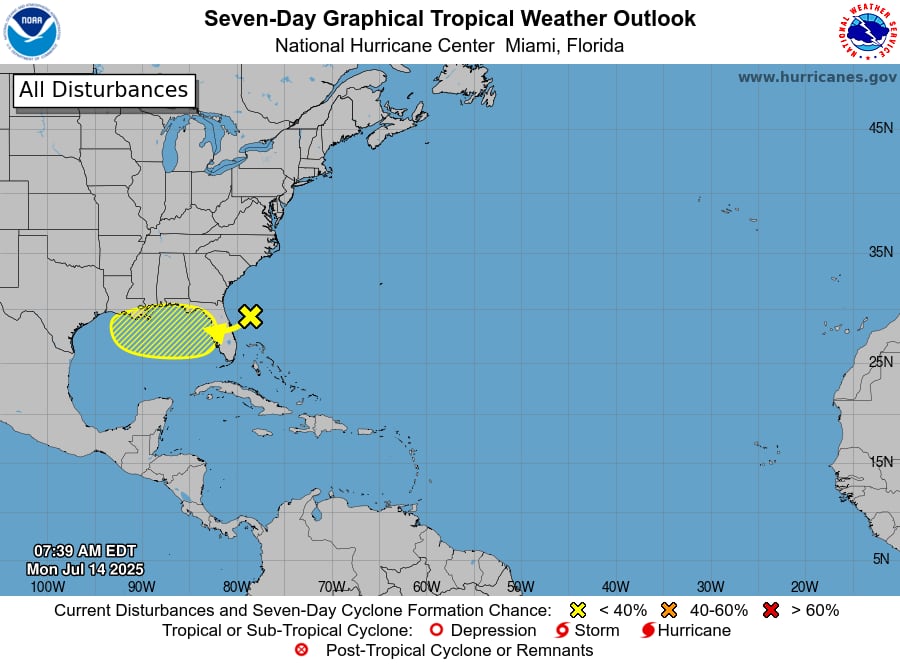On Friday at 7:38 p.m. an updated severe thunderstorm warning was issued by the National Weather Service in effect until 8:15 p.m. for Geneva County.
The storms are packing penny-sized hail (0.75 inches) and wind gusts of up to 60 mph.
“At 7:38 p.m., severe thunderstorms were located along a line extending from near Geneva to 8 miles north of De Funiak Springs, moving east at 15 mph,” says the weather service. “Expect damage to roofs, siding, and trees.”
Locations impacted by the warning include Geneva, Union, Ponce De Leon, Caryville, Esto, Westville, Black, Kellys Crossroads, Gaskin, Cerrogordo, Darlington, Gritney, Arrant Settlement, Geneva Municipal A/P, Glendale, Smith Crossroads, Hickory Hill, Izagora, New Hope and Somerset.
The weather service adds, “Large hail, damaging wind, and continuous cloud to ground lightning are occurring with these storms. Move indoors immediately. Lightning is one of nature’s leading killers. Remember, if you can hear thunder, you are close enough to be struck by lightning. Torrential rainfall is occurring with these storms, and may lead to flash flooding. Do not drive your vehicle through flooded roadways.”
Preparing for impending lightning strikes: Expert safety recommendations
Each year, lightning strikes the United States approximately 25 million times, with the majority of these electrifying events occurring during the summer months. Unfortunately, lightning is responsible for claiming the lives of approximately 20 people annually, as reported by the weather service. The threat of lightning becomes more pronounced as thunderstorms draw nearer, peaking when the storm is directly overhead and gradually waning as it moves away.
To ensure your safety during a thunderstorm, consider the following recommendations:
Lightning safety plan:
-
When venturing outdoors, it’s crucial to have a lightning safety plan in place.
-
Monitor the sky for threatening signs and listen for the sound of thunder. If thunder is audible, it’s an indication that lightning is nearby.
-
Seek shelter promptly in a safe location, preferably indoors.
Indoors safety measures:
-
Once you’ve found shelter indoors, abstain from using corded phones, electrical appliances, or plumbing fixtures, and refrain from approaching windows and doors.
-
These precautions help reduce the risk of electrical surges, as lightning can follow conductive pathways.
Wait for the all-clear:
-
After the last lightning strike or thunderclap, wait at least 30 minutes before resuming outdoor activities.
-
Lightning can strike even when a storm has seemingly passed, so exercise caution.
When indoor shelter isn’t available:
If you find yourself outdoors with no access to indoor shelter during a thunderstorm, take these steps to maximize your safety:
-
Avoid open fields, hilltops, or ridge crests, as they expose you to greater lightning risk.
-
Steer clear of tall, isolated trees and other prominent objects. In wooded areas, stay close to lower stands of trees.
-
If you’re with a group, ensure individuals are spread out to prevent lightning current from transferring between people.
-
Camping in an open setting during a thunderstorm is strongly discouraged. If no alternative exists, set up camp in a valley, ravine, or other low-lying areas. Remember that a tent offers no protection against lightning.
-
Do not approach water bodies, wet objects, or metal items. Although water and metal do not attract lightning, they conduct electricity effectively and can pose significant risks.
In summary, when facing the threat of lightning, vigilance and preparedness are your best allies. By following these guidelines, you can significantly reduce the chances of lightning-related accidents and prioritize your safety.
Mastering wet roads: Safety tips for heavy rainfall
When heavy rain sets in, the risk of flooding and hazardous driving conditions rises. Whether it’s prolonged rainfall or rapid runoff, being prepared is essential. Here are some valuable safety tips from the weather service to ensure you stay safe in heavy rain:
Beware of rapid water flow:
Avoid parking or walking in close proximity to culverts or drainage ditches, as the swiftly moving water during heavy rain can potentially carry you away.
Maintain safe driving distances:
Use the two-second rule to maintain a safe distance from the car in front of you and allow an extra two seconds in heavy rain.
Reduce speed and drive cautiously:
On wet roads, reducing your speed is crucial. Ease off the gas pedal gradually and avoid abrupt braking to prevent skidding.
Choose your lane wisely:
Stay toward the middle lanes – water tends to pool in the outside lanes.
Visibility matters:
Enhance your visibility in heavy rain by activating your headlights. Be particularly vigilant for vehicles in blind spots, as rain-smeared windows can obscure them.
Watch out for slippery roads:
The first half-hour of rain is when roads are slickest due to a mix of rain, grime, and oil. Exercise heightened caution during this period.
Keep a safe distance from large vehicles:
Large trucks and buses can reduce your visibility with tire spray. Avoid tailgating and pass them swiftly and safely.
Mind your windshield wipers:
Overloaded wiper blades can hinder visibility. If rain severely limits your sight, pull over and wait for conditions to improve. Seek refuge at rest areas or protected spots.
When stopping by the roadside is your only option, position your vehicle as far off the road as possible, ideally beyond guardrails. Keep your headlights on and activate emergency flashers to alert other drivers of your position.
In the face of heavy rain, these precautions can make a significant difference in ensuring your safety on the road. Remember to stay informed about weather conditions and heed guidance from local authorities for a secure journey.
Advance Local Weather Alerts is a service provided by United Robots, which uses machine learning to compile the latest data from the National Weather Service.



